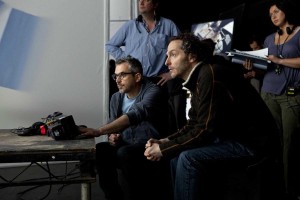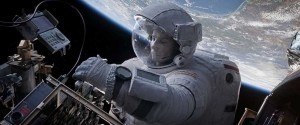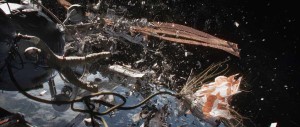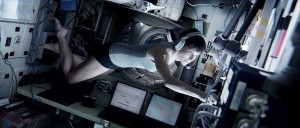
Gravity tells the story of an astronaut, played by Sandra Bullock, who, while on her first shuttle mission, gets flung into the blackness of space when disaster strikes in the form of flying satellite debris. With their spacecraft all but destroyed, She and a more seasoned astronaut, portrayed by George Clooney, are tethered only to each other as they face the ultimate battle for survival.
Directed by Alfonse Cuarón, the 3D film is already being hailed as a landmark for convincing audiences of what it feels and looks like to experience outer space. Four-and-a-half years in the making, Gravity also represents state-of-the-art technology in its marriage of cinematography with CGI.
Cuarón’s long-time collaborator, director of photography Emmanuel “Chivo” Lubezki, worked with a top-notch team at Framestore, a leading viz effects outfit in London, led by Tim Webber. The goal was to make it seem like an actual movie camera had been taken into space to photograph the story. Lubezki, who has been Oscar nominated for best cinematography five times, said that in effect a “virtual” camera was created and used.
 “I had to reinvent myself, learning to use a new set of tools and working with a different kind of crew,” said the DP. “Instead of having a gaffer, I had 12 young artists sitting at computers, and we worked for months lighting the movie and composing the shots.”
“I had to reinvent myself, learning to use a new set of tools and working with a different kind of crew,” said the DP. “Instead of having a gaffer, I had 12 young artists sitting at computers, and we worked for months lighting the movie and composing the shots.”
The preparation stage took two years. “The shoot of the main characters was the shortest part of the process, and came at the end,” said Lubezki. “Previz was almost finished. We knew what the surroundings and the environment looked like. We knew almost 90 percent of how Sandra was going to move in space and also George. It was almost finished before we were able to incorporate them.”
There is one particularly gripping scene where Bullock has made it back to the damaged shuttle and is trying to get into the airlock and back into the ship, which requires clambering over the multi-surfaced exterior. “It was very complex,” he noted. “We put it together in pieces, and the methodology for each was very different. Sometimes Sandra was hanging on cables, sometimes Sandra was hanging on a bar, sometimes she was inside what we call an LED box that was made just for the film. Sometimes Sandra was not there at all.”
 “We could have not asked for a better actress to do this movie,” said the DP. “She not only brought all the internal aspects of the character to her work, she also brought this extraordinary agility and flexibility,” he added. “She could be a member of the Cirque de Soleil.”
“We could have not asked for a better actress to do this movie,” said the DP. “She not only brought all the internal aspects of the character to her work, she also brought this extraordinary agility and flexibility,” he added. “She could be a member of the Cirque de Soleil.”
There were also extended close-ups of Bullock’s face seen through the visor of her space helmet. “I needed to have the shadows of the helmet acting on her face to make it believable and to help with the integration of the virtual cinematography with the live cinematography,” he explained. “Sometimes she did not have the glass, because the camera had to go so close to her face. Sometimes it was only inches from her face.”
The DP said he did not reference other movies, though he expressed admiration for 2001: A Space Odyssey and Apollo 13. However, he and Cuarón poured over pictures and video from NASA under consideration that people are familiar with scenes of astronauts outside various space capsules and how the earth looks like from outer space. “When you do a CGI movie and the theme of the movie is far from reality you have an easier time,” said Lubezki. “Because we were so close to reality and people have seen these photos, we had to make the audience believe that what they were looking at was real.”
 Lubezki bristles at assertions that what he did on the film, was not cinematography in the conventional sense. “It is cinematography. It’s almost exactly what I’ve done in all my previous movies,” he averred. “Even though I didn’t carry a camera in a spacecraft, we had to create all these environments, we had to light them, to frame and design all of the shots. It’s all the same.”
Lubezki bristles at assertions that what he did on the film, was not cinematography in the conventional sense. “It is cinematography. It’s almost exactly what I’ve done in all my previous movies,” he averred. “Even though I didn’t carry a camera in a spacecraft, we had to create all these environments, we had to light them, to frame and design all of the shots. It’s all the same.”
“Cinematographers are going to have to learn to use all these new tools in order to be able to participate in these new kinds of films,” he declared. “For some of us it’s scary, and for some of us it’s incredibly exciting because it widens the possibilities”.
As special effects become cheaper, “more directors are going to want to use these tools to tell stories that before were impossible to tell, and to put the camera – the virtual camera – in places they couldn’t before,” he noted. “I think the language of film is going to change. Gravity could not have been made a few years ago, or even months ago. These changes are coming very fast.”
Lubezki received two of his Oscar nominations for films he did with director Cuarón, A Little Princess and Children of Men. He also directed photography on Cuarón’s Love in the Time of Hysteria, Great Expectations and Y Tu Mama Tambien. His other Academy Award nominations came for Tim Burton’s Sleepy Hollow, and two Terrence Malick films, The New World and The Tree of Life. He reteamed with Malick on this year’s To the Wonder and the upcoming Knight of Cups. Lubezki’s is also set to lens Birdman with Alejandro González Iñárritu.





